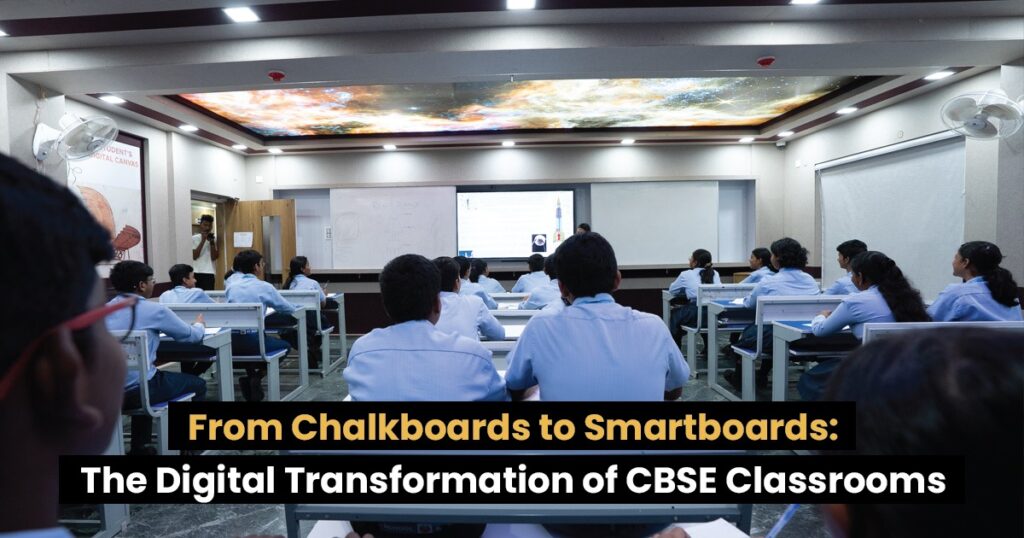- November 20, 2025
- KT Global School
- 0

Imagine walking into a classroom where the teacher isn’t just scribbling on a dusty chalkboard but instead swipes through vibrant lessons on a glowing smartboard, plays interactive videos, and engages students with quizzes in real-time. Sounds futuristic? Well, this is the reality now in many CBSE schools, especially among the top schools in Bhubaneswar.
The days of noisy chalk squeaks and dusty erasers are giving way to a new era—an era where classrooms are digitally transformed hubs of learning. Let’s explore how this shift is reshaping education in Bhubaneswar and why it matters.
The Traditional Chalkboard: Strengths and Limitations
For decades, the chalkboard has been the fundamental teaching tool in CBSE classrooms. It allowed teachers to present information visually, and students followed by copying notes. The chalkboard’s simplicity and affordability made it accessible across schools in India.
However, despite its strengths, chalkboards have clear limitations:
◆ Limited Interaction: The chalkboard is a one-way communication tool where the teacher talks, and students listen passively.
◆ Static Content: Complex concepts, especially in science and math, are hard to explain effectively without dynamic visuals.
◆ Time-Consuming: Writing and erasing on the board takes time, reducing the pace of lessons.
◆ Health Concerns: Chalk dust can cause allergies and respiratory issues for some students and teachers.
Given these limitations, the need for modern teaching tools that engage students and enhance learning outcomes became evident.
Smartboards: Revolutionizing CBSE Classrooms
Smartboards, also known as interactive whiteboards, integrate computer technology with traditional classroom teaching. They allow teachers to display multimedia content such as videos, animations, interactive exercises, and live internet access. The smartboard is touch-sensitive, enabling teachers and students to interact directly with the content.
Key Features of Smartboards:
◆ Interactive Lessons: Teachers can use multimedia tools, highlight key points, and annotate on the screen.
◆ Real-Time Assessment: Instant quizzes and polls help teachers evaluate student understanding.
◆ Collaborative Learning: Students can work together on the smartboard, encouraging group participation.
◆ Access to Online Resources: Teachers can bring in updated content from around the world.
Why the Digital Transformation Matters for CBSE Classrooms
The shift from chalkboards to smartboards is not merely technological but pedagogical. Here’s why it is crucial for CBSE classrooms:
◆ Enhanced Student Engagement
Digital tools make lessons interactive and stimulating, which significantly boosts student engagement. Visuals, animations, and interactive quizzes appeal to various learning styles, keeping students attentive and involved.
◆ Better Conceptual Clarity
Complex topics in subjects like Science and Mathematics become easier to understand with digital simulations and graphical representations available on smartboards. This helps in better retention and practical understanding.
◆ Personalized Learning
Smartboards allow teachers to customize lessons according to the class’s pace and individual needs. Immediate feedback from digital assessments helps teachers identify struggling students early.
◆ Developing 21st-Century Skills
Using technology in classrooms enhances students’ digital literacy—an essential skill for future education and employment.
The Role of Top Schools in Bhubaneswar in Driving Digital Classrooms
Bhubaneswar has emerged as an educational hub in eastern India, housing several top schools that follow the CBSE curriculum. These schools have recognized the importance of integrating technology into their classrooms to provide students with quality education that matches global standards.
The top schools in Bhubaneswar have invested in smartboards and other digital infrastructure to create smart classrooms. This transformation reflects a broader commitment to blending traditional educational values with modern teaching methods.
How Top Schools in Bhubaneswar Are Implementing Smart Classrooms:
◆ Upgrading infrastructure with the latest smartboard technology.
◆ Training teachers extensively to maximize the potential of digital tools.
◆ Creating interactive lesson plans that leverage multimedia content.
◆ Ensuring students from all backgrounds have access to these digital resources.
Challenges in Transitioning to Digital Classrooms and How Schools Address Them
While the benefits are clear, the shift from chalkboards to smartboards is not without obstacles:
◆ Initial Investment: Smartboards and related digital equipment can be costly. However, top schools in Bhubaneswar prioritize this investment due to the long-term benefits.
◆ Teacher Training: Effective use of technology requires well-trained teachers. Continuous professional development programs are essential.
◆ Digital Divide: Some students may face challenges accessing digital devices at home. Schools are increasingly providing support and resources to bridge this gap.
◆ Technical Maintenance: Regular maintenance and troubleshooting require dedicated IT support within schools.
The Impact on Students: Learning in a Digital CBSE Classroom
The digital transformation positively impacts students’ learning experiences:
◆ Engagement and Motivation: Interactive lessons keep students motivated and improve participation.
◆ Improved Academic Performance: Enhanced visualization and hands-on learning improve understanding and exam readiness.
◆ Collaboration and Communication: Smartboards encourage group work, discussions, and peer learning.
◆ Skill Development: Exposure to technology prepares students for future academic and career challenges.
What Lies Ahead for CBSE Classrooms in Bhubaneswar?
The digital transformation of classrooms is an ongoing process. Future advancements like virtual reality (VR), augmented reality (AR), and AI-based personalized learning are on the horizon and likely to become integral parts of CBSE education.
The top schools in Bhubaneswar are already exploring these innovations to keep their students ahead of the curve. By combining smartboards with emerging technologies, they aim to create immersive, adaptive, and student-centric learning environments.
Conclusion
The transition from chalkboards to smartboards marks a significant milestone in the modernization of CBSE classrooms. This change enhances teaching effectiveness, student engagement, and learning outcomes, preparing students to thrive in a digital world.
Bhubaneswar’s top schools are championing this transformation, setting benchmarks for quality education through smart classrooms. As technology continues to evolve, the city’s CBSE schools are poised to deliver education that is interactive, inclusive, and future-ready.
For parents and educators in Bhubaneswar, understanding this digital shift is essential to support students’ growth in a rapidly changing educational landscape.
